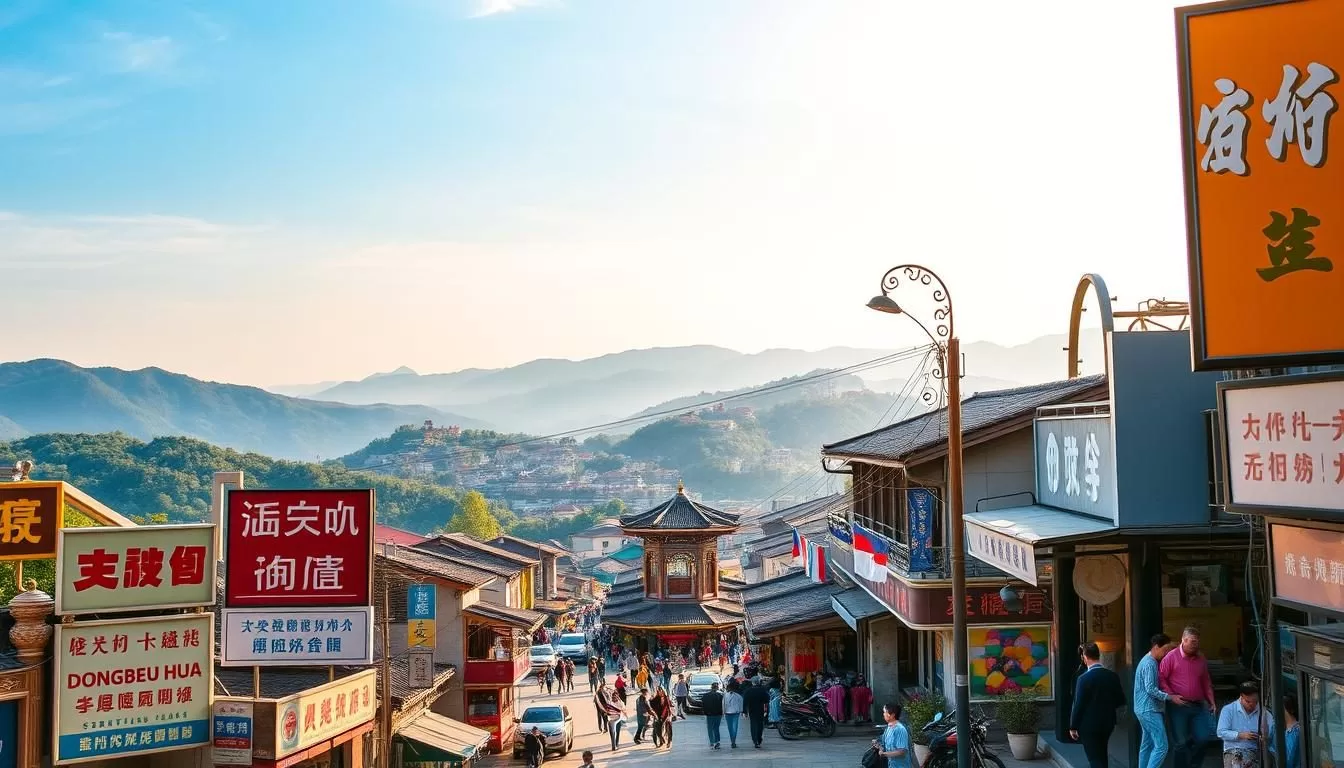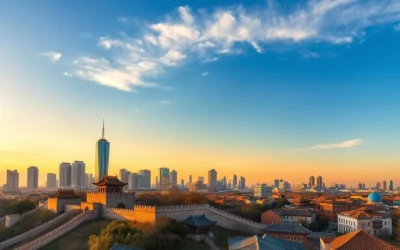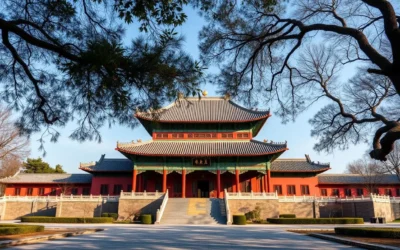✓ Accommodations✓ Flights✓ Rental Cars
Have you ever wondered about the linguistic diversity of one of Northeast China’s most vibrant regions? Located along the coast, this area is home to over 42 million people, making it the most populous in its region. Its capital, Shenyang, and major cities like Dalian are not just economic hubs but also global leaders in scientific research.
The Chinese language is the official tongue here, but the region’s rich history has shaped a unique linguistic identity. From its name change from Fengtian to its current title, the area reflects a blend of tradition and modernity. Government initiatives and educational programs play a key role in standardizing language use while preserving local dialects.
This coastal region’s geographical position at 41°06′N 122°18′E contributes to its cultural richness. Whether you’re exploring its bustling cities or diving into its historical roots, you’ll find a fascinating mix of influences. Ready to learn more? Let’s dive deeper into its language and cultural tapestry.
Understanding Liaoning’s Linguistic Landscape
Exploring the linguistic diversity of this region reveals a fascinating blend of traditions. The area’s official language is Mandarin, spoken by over 70% of the population. However, regional dialects like Northeastern Mandarin add a unique flavor to everyday communication.

Official Languages and Regional Dialects
Mandarin serves as the primary medium of instruction in 95% of schools. Yet, dialects such as Jiaoliao Mandarin are widely used, especially in rural areas. These dialects reflect the region’s historical migrations and cultural exchanges.
Urban centers like Shenyang and Dalian are linguistic hubs, where over 80% of residents are fluent in Mandarin. In contrast, rural areas see a higher prevalence of local dialects, showcasing the area’s linguistic variety.
Diverse Minority Languages and Cultural Roots
Minority languages like Korean and Manchu form an essential part of the cultural fabric. Though less than 5% of the population speaks these languages, they hold historical significance. Communities influenced by Inner Mongolia also contribute to this linguistic mosaic.
Government initiatives allocate significant resources to preserve these languages. Over 200 language schools focus on minority dialects, ensuring their survival for future generations. This effort highlights the region’s commitment to cultural diversity.
Understanding this linguistic landscape is key to appreciating the area’s rich heritage. From bustling cities to quiet villages, the variety of languages and dialects tells a story of unity in diversity.
Historical Evolution of Language in Liaoning
The history of language in this region is a tale of cultural shifts and migrations. Over time, the area has seen a blend of ancient traditions and modern influences, shaping its linguistic identity.

Ancient Influences and Early Settlements
Early settlements in the region were heavily influenced by ancient civilizations. The Han dynasty’s commanderies played a key role in shaping the local language. These early interactions laid the foundation for the linguistic variety seen today.
During the Liao and Jin dynasties, the area became a cultural hub. This period saw the introduction of new dialects and words, enriching the linguistic landscape.
Migrations, Warlord Eras, and Modern Changes
Migration trends have significantly impacted the region’s language. People moving in and out brought new dialects and cultural practices. Cities like Shenyang became melting pots of linguistic diversity.
The warlord eras and modern political restructuring further standardized the language. Government policies during the Qing dynasty and later administrations played a crucial role in this process.
Today, the historical narratives continue to influence the linguistic landscape. From ancient settlements to modern cities, the evolution of language reflects the region’s rich heritage.
Geographical Impacts on Language and Dialect Diversity
Geography plays a key role in shaping the way people speak. Natural barriers like mountains, rivers, and coastlines often create isolated communities. These communities develop their own unique dialects over time.

The Liao River, for example, acts as a natural divider. It separates the central plains from the coastal areas. This separation has led to distinct linguistic traits in each part of the region.
Coastal Areas, Highlands, and the Influence of Natural Barriers
Coastal areas tend to have a different dialect system compared to highlands. The coastal Liaodong Peninsula is influenced by its proximity to the sea. This has shaped a unique linguistic character among its speakers.
In contrast, the highlands near Inner Mongolia have their own dialect variety. The rugged terrain has historically limited interaction with other groups. This isolation has preserved older linguistic features.
Cities like Shenyang and Dalian showcase how geography impacts language. Shenyang, located in the central plains, has a more standardized dialect. Dalian, on the coast, retains a distinct local flavor.
“Natural barriers don’t just shape landscapes—they shape cultures and languages.”
Understanding these geographical influences helps explain the region’s linguistic diversity. From the mountains to the coast, each area tells a story of adaptation and isolation.
Modern Trends in Language Use and Education
Language education today reflects a blend of tradition and innovation. The government has implemented policies to standardize Mandarin while preserving local dialects. Over 60% of ethnic minority students are educated in their native languages, with a focus on integrating Mandarin as a second language.

Language Policies and Government Support
Modern language policies aim to unify the nation while respecting cultural diversity. The promotion of Mandarin since 1956 has been a cornerstone of these efforts. Bilingual education programs have seen a 30% increase in enrollment over the past decade, particularly in regions with significant minority populations.
Government initiatives also focus on preserving endangered languages. Over 200 language schools are dedicated to teaching minority dialects, ensuring their survival for future generations. This balance between standardization and preservation highlights the region’s commitment to linguistic diversity.
Cultural Identity and the Role of Education
Education plays a crucial role in maintaining cultural identity. Schools not only teach the Chinese language but also emphasize the importance of local dialects. Research shows that students maintaining their home language are 25% more likely to succeed academically.
Urban areas like Shenyang and Dalian showcase a higher prevalence of Mandarin fluency. In contrast, rural regions retain a stronger connection to local dialects. This difference reflects the diverse linguistic landscape shaped by population trends.
“Education is the bridge between preserving the past and embracing the future.”
Global influences and technology are also shaping language use. The rise of digital platforms has increased the demand for language education, particularly in Mandarin and local dialects. Programs like the Belt and Road Initiative have further fueled this demand, with a 20% increase in related course enrollments.
For more insights into how globalization impacts language use, explore this detailed analysis. Additionally, learn about public attitudes toward dialects in this study.
Liaoning Province, China: Official and widely spoken languages
The government plays a pivotal role in shaping the linguistic identity of this region. Through targeted programs, it balances modern demands with the preservation of historical dialects. Over 200 language schools focus on teaching minority languages, ensuring their survival for future generations.
Current Programs and Policies
Modern initiatives aim to standardize Mandarin while safeguarding local dialects. The nationwide Mandarin proficiency rate reached 80.72% in 2020, up from 53.06% in 2000. This growth reflects the success of educational reforms and language policies.
In urban centers like Shenyang and Dalian, over 80% of residents are fluent in Mandarin. Rural areas, however, retain a stronger connection to local dialects. This dual approach ensures cultural diversity while promoting a unified language system.
Cultural Festivals and Community Involvement
Local groups and speakers play a vital role in keeping traditional forms alive. Cultural festivals celebrate minority languages, fostering pride and awareness. These events highlight the region’s commitment to its linguistic legacy.
“Language is the roadmap of a culture. It tells you where its people came from and where they are going.”
Government support extends to language training programs. Over 60% of ethnic minority students are educated in their native languages, with Mandarin as a second language. This approach helps maintain cultural identity while preparing students for a globalized world.
| Initiative | Impact |
|---|---|
| Language Schools | Preserves minority dialects |
| Cultural Festivals | Promotes awareness and pride |
| Bilingual Education | Balances tradition and modernity |
For more insights into language policies, explore this detailed analysis. Additionally, learn about the region’s cultural diversity in this comprehensive guide.
Conclusion
Every part of this vibrant region tells a story through its language. From the historical roots shaped by ancient migrations to the modern policies promoting Mandarin, the area showcases a unique blend of tradition and progress.
Geographical barriers have played a key role in preserving local dialects, while urban centers embrace standardized Mandarin. Today, over 95% of youth are literate in Mandarin, reflecting the success of educational reforms.
Government and community efforts ensure that minority languages remain alive. Cultural festivals and language schools highlight the region’s commitment to its linguistic heritage.
This country’s approach to language reflects its broader cultural identity. It balances unity with diversity, making it a fascinating study for anyone interested in how language shapes society. To learn more about these dynamics, explore this detailed analysis.
Take a moment to appreciate the rich tapestry of voices that define this region. It’s a reminder that every word carries a piece of history and culture.
The above is subject to change.
Check back often to TRAVEL.COM for the latest travel tips and deals.






